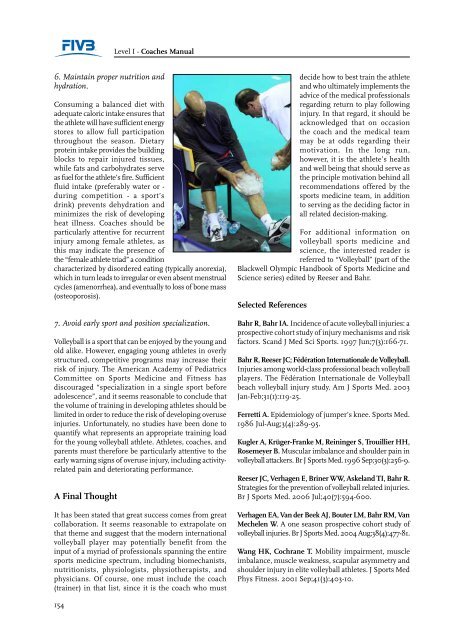COACHES MANUAL
Download
Download
- No tags were found...
You also want an ePaper? Increase the reach of your titles
YUMPU automatically turns print PDFs into web optimized ePapers that Google loves.
Level I - Coaches Manual<br />
6. Maintain proper nutrition and<br />
hydration.<br />
Consuming a balanced diet with<br />
adequate caloric intake ensures that<br />
the athlete will have sufficient energy<br />
stores to allow full participation<br />
throughout the season. Dietary<br />
protein intake provides the building<br />
blocks to repair injured tissues,<br />
while fats and carbohydrates serve<br />
as fuel for the athlete’s fire. Sufficient<br />
fluid intake (preferably water or -<br />
during competition - a sport’s<br />
drink) prevents dehydration and<br />
minimizes the risk of developing<br />
heat illness. Coaches should be<br />
particularly attentive for recurrent<br />
injury among female athletes, as<br />
this may indicate the presence of<br />
the “female athlete triad” a condition<br />
characterized by disordered eating (typically anorexia),<br />
which in turn leads to irregular or even absent menstrual<br />
cycles (amenorrhea), and eventually to loss of bone mass<br />
(osteoporosis).<br />
7. Avoid early sport and position specialization.<br />
Volleyball is a sport that can be enjoyed by the young and<br />
old alike. However, engaging young athletes in overly<br />
structured, competitive programs may increase their<br />
risk of injury. The American Academy of Pediatrics<br />
Committee on Sports Medicine and Fitness has<br />
discouraged “specialization in a single sport before<br />
adolescence”, and it seems reasonable to conclude that<br />
the volume of training in developing athletes should be<br />
limited in order to reduce the risk of developing overuse<br />
injuries. Unfortunately, no studies have been done to<br />
quantify what represents an appropriate training load<br />
for the young volleyball athlete. Athletes, coaches, and<br />
parents must therefore be particularly attentive to the<br />
early warning signs of overuse injury, including activityrelated<br />
pain and deteriorating performance.<br />
A Final Thought<br />
It has been stated that great success comes from great<br />
collaboration. It seems reasonable to extrapolate on<br />
that theme and suggest that the modern international<br />
volleyball player may potentially benefit from the<br />
input of a myriad of professionals spanning the entire<br />
sports medicine spectrum, including biomechanists,<br />
nutritionists, physiologists, physiotherapists, and<br />
physicians. Of course, one must include the coach<br />
(trainer) in that list, since it is the coach who must<br />
decide how to best train the athlete<br />
and who ultimately implements the<br />
advice of the medical professionals<br />
regarding return to play following<br />
injury. In that regard, it should be<br />
acknowledged that on occasion<br />
the coach and the medical team<br />
may be at odds regarding their<br />
motivation. In the long run,<br />
however, it is the athlete’s health<br />
and well being that should serve as<br />
the principle motivation behind all<br />
recommendations offered by the<br />
sports medicine team, in addition<br />
to serving as the deciding factor in<br />
all related decision-making.<br />
For additional information on<br />
volleyball sports medicine and<br />
science, the interested reader is<br />
referred to “Volleyball” (part of the<br />
Blackwell Olympic Handbook of Sports Medicine and<br />
Science series) edited by Reeser and Bahr.<br />
Selected References<br />
Bahr R, Bahr IA. Incidence of acute volleyball injuries: a<br />
prospective cohort study of injury mechanisms and risk<br />
factors. Scand J Med Sci Sports. 1997 Jun;7(3):166-71.<br />
Bahr R, Reeser JC; Fédération Internationale de Volleyball.<br />
Injuries among world-class professional beach volleyball<br />
players. The Fédération Internationale de Volleyball<br />
beach volleyball injury study. Am J Sports Med. 2003<br />
Jan-Feb;31(1):119-25.<br />
Ferretti A. Epidemiology of jumper’s knee. Sports Med.<br />
1986 Jul-Aug;3(4):289-95.<br />
Kugler A, Krüger-Franke M, Reininger S, Trouillier HH,<br />
Rosemeyer B. Muscular imbalance and shoulder pain in<br />
volleyball attackers. Br J Sports Med. 1996 Sep;30(3):256-9.<br />
Reeser JC, Verhagen E, Briner WW, Askeland TI, Bahr R.<br />
Strategies for the prevention of volleyball related injuries.<br />
Br J Sports Med. 2006 Jul;40(7):594-600.<br />
Verhagen EA, Van der Beek AJ, Bouter LM, Bahr RM, Van<br />
Mechelen W. A one season prospective cohort study of<br />
volleyball injuries. Br J Sports Med. 2004 Aug;38(4):477-81.<br />
Wang HK, Cochrane T. Mobility impairment, muscle<br />
imbalance, muscle weakness, scapular asymmetry and<br />
shoulder injury in elite volleyball athletes. J Sports Med<br />
Phys Fitness. 2001 Sep;41(3):403-10.<br />
154



